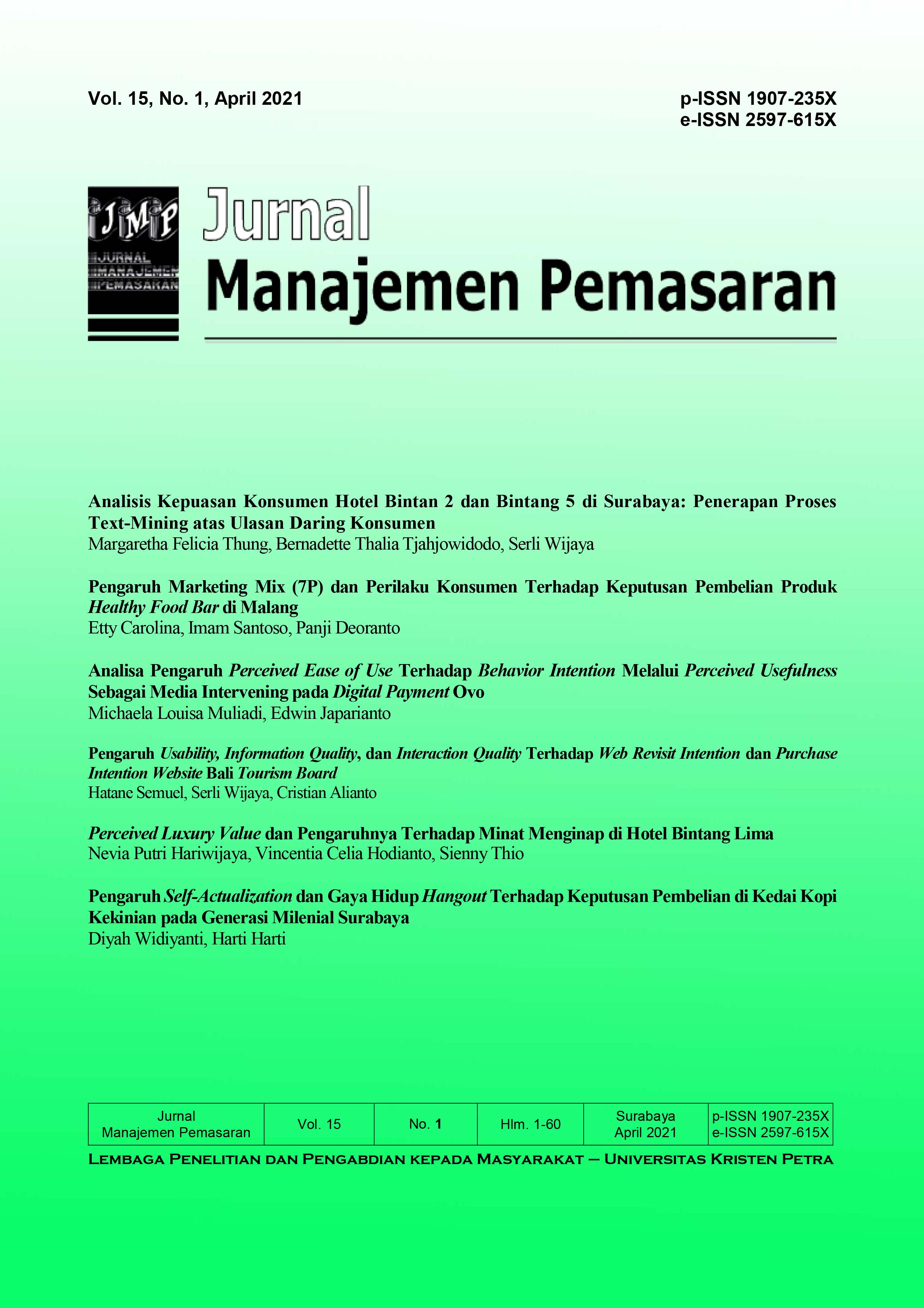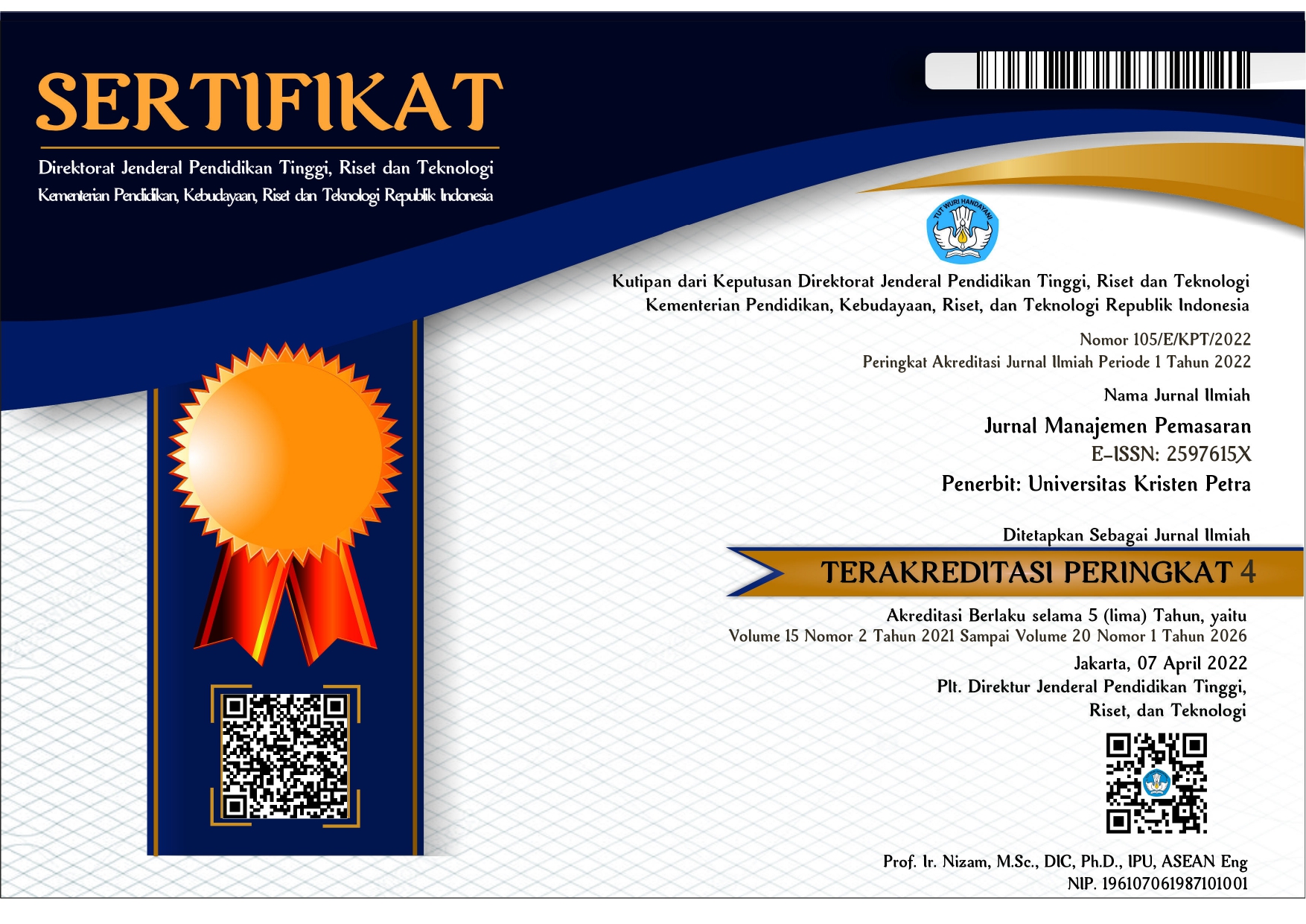VIRAL MARKETING MESSAGE, CONSUMERS’ ATTITUDE TOWARDS VIRAL MARKETING, COMPETITIVENESS ABILITY, AND BUSINESS PERFORMANCE
DOI:
https://doi.org/10.9744/pemasaran.15.2.83-96Keywords:
Online marketing communication, viral marketing message, consumers’ attitude toward viral marketing, competitiveness ability, business performanceAbstract
Empowerment of technology and the use of digital media that are currently practiced through appropriate marketing strategies and tactics will be able to make businesses survive in the midst of the Covid-19 pandemic. Viral marketing strategy is a low-cost effective marketing strategy for mass targeting. Powerful viral promotions can reach thousands of consumers, can inspire them to buy certain branded products, and create a competitive advantage for businesses. This study takes the Tanggulangin leather craft SMEs as one of the centers of the leather industry in Indonesia, with the research variables being viral marketing message strategies, consumer attitudes towards viral marketing, competitiveness ability, and business performance. The study was conducted on 235 respondents who met the requirements of the research provisions. Data analysis using SmartPLS 3. The results obtained are that viral marketing massage has a direct positive effect on consumer attitudes towards viral marketing, competitiveness, and business performance. Consumer attitudes towards viral marketing have a direct positive effect on competitiveness and business performance. In addition, consumer attitudes towards viral marketing partially mediate the relationship between viral marketing messages and competitiveness, and competitive ability partially mediates the relationship between consumer attitudes towards viral marketing and business performance.
References
Aaker, D. A. (1996). Measuring brand equity across products and markets. California Management Review, 38(3).
Ahmad, S. Z., Abu Bakar, A. R., & Ahmad, N. (2019). Social media adoption and its impact on firm performance: the case of the UAE. International Journal of Entrepreneurial Behaviour and Research, 25(1), 84–111. https://doi.org/10. 1108/IJEBR-08-2017-0299.
Ajzen, I. (1987). Attitudes, traits and actions: Dispo-sitional prediction of behaviour in social pshychology. In Advances in Experimental Social Psychology (Vol. 20).
Alkharabsheh, K. S., Alsarayreh, M. N., Rumman, M. A., & Al Farajat, A. H. (2011). The impact of viral marketing via Internet on promotion of tourism products in Jordan. International Research Journal of Finance and Economics, 80(May), 138–147.
Antara & Setiawan, K. (2020). Bank Indonesia: Transaksi e-commerce agustus 2020 naik hingga mencapai 140 Juta. https://bisnis.tempo. co/read/1398066/bank-indonesia-transaksi-e-commerce-agustus-2020-naik-hingga-mencapai-140-juta?page_num=2.
Badan Pusat Statistik. (2020). Berita resmi statistik. In Badan Pusat Statistik (Issue 7/01/Th.XXIV). bps.go.id.
Bampo, M., Ewing, M. T., Mather, D. R., Stewart, D., & Wallace, M. (2008). The effects of the social structure of digital networks on viral marketing performance. Information Systems Research, 19(3), 273–290. https://doi.org/10.1287/isre. 1070.0152.
Bauer, H. H., Reichardt, T., Barnes, S. J., & Marcus, M. N. (2005). Driving consumer acceptance of location-based services in mobile applications: A theoretical framework and an empirical study. Journal of Electronic Commerce Research, 6(3), 181–192.
Bella, A. (2018). Potensi besar industri kulit di Indo-nesia. Marketeers.Com. https://marketeers.com/ potensi-besar-industri-kulit-di-indonesia/
Bramasta, D. B. (2020). Odading mang oleh viral, begini sejarah penamaannya. Kompas.Com, 1–6. https://www.kompas.com/tren/read/2020/09/ 17/183838465/odading-mang-oleh-viral-begini-sejarah-penamaannya?page=all.
Castronovo, C., & Huang, L. (2012). Social media in an alternative marketing communication model. Journal of Marketing Development and Com-petitiveness, 6(1), 117–134.
Chau, P. Y. K., & Tam, K. Y. (1997). Factors affecting the adoption of open systems: An exploratory study. MIS Quarterly: Management Information Systems, 21(1), 1–20. https://doi.org/10.2307/ 249740.
Choi, S. M., & Rifon, N. J. (2002). Antecedents and consequences of web advertising credibility. Journal of Interactive Advertising, 3(1), 12–24. https://doi.org/10.1080/15252019.2002.10722064.
Cruz, D., & Fill, C. (2008). Evaluating viral marketing: Isolating the key criteria. Marketing Intelligence and Planning, 26(7), 743–758. https://doi.org/ 10.1108/02634500810916690
Davis, F. D. (1989). Perceived usefulness, perceived ease of use, and user acceptance of information technology. MIS Quarterly: Management Infor-ma¬¬tion Systems, 13(3), 319–339. https://doi.org/10.2307/249008
De Reyck, B., & Degraeve, Z. (2003). Broadcast scheduling for mobile advertising. Operations Research, 51(4), 509–517. https://doi.org/10. 1287/opre.51.4.509.16104
Dobele, A., Lindgreen, A., Beverland, M., Vanham¬me, J., & van Wijk, R. (2007). Why pass on viral messages? Because they connect emotionally. Business Horizons, 50(4), 291–304. https://doi. org/10.1016/j.bushor.2007.01.004
Ducoffe, R. H. (1996). Advertising value and adver-tising on the web. Journal of Advertising Research, 36(5), 21–21.
Esmaeilpour, M., & Aram, F. (2016). Investigating the impact of viral message appeal and message credibility on consumer attitude toward the brand. Management and Marketing, 11(2), 470–483. https://doi.org/10.1515/mmcks-2016-0010
Evans, N. (2005). Assessing the balanced scorecard as a management tool for hotels. International Journal of Contemporary Hospitality Management, 17(5), 376–390. https://doi.org/10.1108/ 09596110510604805
Evans, P., & Wurster, T. S. (1999). Getting real about virtual commerce. Harvard Business Review, 77(6), 84–94. http://search.ebscohost.com/login. aspx?direct=true&db=buh&AN=2434952&site=ehost-live
Ghane, N., Shokrizadeh, H. R., Omidvar, M., & Comyab, H. (2014). Investigating the effective factors on electronic trade by viral marketing. Management Science Letters, 4(4), 713–720. https://doi.org/10.5267/j.msl.2014.2.020
Godes, D., & Mayzlin, D. (2004). Using online conversations to study word-of-mouth communication. Marketing Science, 23(4), 545–560. https://doi.org/10.1287/mksc.1040.0071
Goldsmith, R. E., & Horowitz, D. (2006). Measuring motivations for online opinion seeking. Journal of Interactive Advertising, 6(2), 2–14. https://doi.org/10.1080/15252019.2006.10722114
Hair, J. F., Hult, G. T. M., Ringle, C. M., & Sarstedt, M. (2014). Multivariate data analysis, 7th edition. USA: Prentice Hall: Pearson Education International.
Haryani, S., & Motwani, B. (2015). Discriminant model for online viral marketing influencing consumers behavioural intention. Pacific Science Review B: Humanities and Social Sciences, 1(1), 49–56. https://doi.org/10.1016/ j.psrb.2015.12.002
Helm, S. (2000). Viral marketing - Establishing customer relationships by “word-of-mouse.” Electronic Markets, 10(3), 158–161. https://doi. org/10.1080/10196780050177053
Icek, A. (1991). The theory of planned behavior organizational behavior and human decision processes. Organizational Behavior and Human Decision Processes, 50(2), 179–211.
Jensen, M. B. (2008). Online marketing communi-cation potential: Priorities in Danish firms and advertising agencies. European Journal of Marketing, 42(3–4), 502–525. https://doi.org/10. 1108/03090560810853039
Kaplan, A. M., & Haenlein, M. (2011). Two hearts in three-quarter time: How to waltz the social media/viral marketing dance. Business Hori¬zons, 54(3), 253–263. https://doi.org/10.1016/ j.bushor.2011.01.006
Krishnamurthy, S. (2001). Understanding online message dissemination: An analysis of Send-this-story-to-your-friend data. First Monday, 6. https://doi.org/https://doi.org/10.5210/fm.v6i5.856
Lee, S. F., Tsai, Y. C., & Jih, W. J. (2006). An empi-rical examination of customer perceptions of mobile advertising. Information Resources Management Journal, 19(4), 39–55. https://doi. org/10.4018/irmj.2006100103
Ma, H. (2000). Competitive advantage and firm performance. Competitiveness Review, 10(2), 15–32. https://doi.org/10.1108/eb046396
MacKenzie, S. B., & Lutz, R. J. (1989). An empirical examination of the structural antecedents of attitude toward the ad in an advertising pretesting context. Journal of Marketing, 53(2), 48–65. https://doi.org/10.2307/1251413
Majedul Huq, S. (2015). Customer’s attitude towards mobile advertising in Bangladesh. International Journal of Business and Economics Research, 4(6), 281–292. https://doi.org/10.11648/j.ijber. 20150406.13
Meyliana, M., E. W., H. A., & Santoso, S. W. (2015). The influence of customers communication behaviour in the implementation of 21cineplex viral marketing using the social networking site Facebook. CommIT (Communication and Infor-mation Technology) Journal, 9(1), 11–18. https://doi.org/10.21512/commit.v9i1.863
Mohr, I. (2017). Managing buzz marketing in the digital age. Journal of Marketing Development and Competitiveness, 11(2), 10–16.
Molina-Azorín, J. F., Tarí, J. J., Pereira-Moliner, J., López-Gamero, M. D., & Pertusa-Ortega, E. M. (2015). The effects of quality and environmental management on competitive advantage: A mixed methods study in the hotel industry. Tourism Management, 50, 41–54. https://doi. org/10.1016/j.tourman.2015.01.008
Müller, J., & Christandl, F. (2019). Content is king – But who is the king of kings? The effect of content marketing, sponsored content & user-generated content on brand responses. Computers in Human Behavior, 96(February), 46–55. https://doi.org/10.1016/j.chb.2019.02.006
Murphy, G. B., & Callaway, S. K. (2004). Doing well and happy about it? Explaining variance in entrepreneurs’ stated satisfaction with perfor-mance. New England Journal of Entrepreneur-ship, 7(2), 15–26. https://doi.org/10.1108/neje-07-02-2004-b003
Nielsen. (2015). Global trust in advertising. The Nielsen Company, September, 1–22.
Oh, L., & Xu, H. (2003). Effects of multimedia on mobile consumer behavior: An empirical study of location-aware advertising. ICiS 2003 Proceedings, 56.
Palka, W., Pousttchi, K., & Wiedemann, D. G. (2009). Mobile word-of-mouth - A grounded theory of mobile viral marketing. Journal of Information Technology, 24(2), 172–185. https://doi.org/10. 1057/jit.2008.37
Pandey, J., Sunaina, R., & Sundar, A. (2012). A study on factors affecting the exposure to viral marketing messages. International Journal of Management & Business Studies, 2(1), 105–111.
Panigyrakis, G. G., & Theodoridis, P. K. (2007). Market orientation and performance: An empirical investigation in the retail industry in Greece. Journal of Retailing and Consumer Services, 14(2), 137–149. https://doi.org/10. 1016/j.jretconser.2006.05.003
Park, D. H., Lee, J., & Han, I. (2007). The effect of on-line consumer reviews on consumer purchasing intention: The moderating role of involvement. International Journal of Electronic Commerce, 11(4), 125–148. https://doi.org/10.2753/JEC 1086-4415110405
Pavlou, P. a, & Fygenson, M. (2006). Understanding and predicting electronic commerce adoption : An extension of the theory of the planned behavior. Mis Quarterly, 30(1), 115–143.
Porter, M. E. (1985). Competitive advantage: creating and sustaining superior performance. Free Press.
Pousttchi, K., & Wiedemann, D. G. (2007). Success factors in mobile viral marketing: A multi-case study approach. Conference Proceedings - 6th International Conference on the Management of Mobile Business, ICMB 2007, May. https://doi.org/10.1109/ICMB.2007.61
Pulizzi, J. (2012). The rise of storytelling as the new marketing. Publishing Research Quarterly, 28(2), 116–123. https://doi.org/10.1007/s12109-012-9264-5
Putri, N. K., & Ernawaty, E. (2019). Viral marketing content for Universal Health Coverage campaign in Indonesia. International Journal of Pharmaceutical and Healthcare Marketing, 14(1), 21–36. https://doi.org/10.1108/IJPHM-07-2017-0041
Rainer Feurer, & Kazem Chaharbaghi. (1994). Defining competitiveness: a holistic approach. Management Decision, 32(2), 49–58. http://repo¬¬sitory.binus.ac.id/2009-2/content/F0542/F054214618.pdf
Rodriguez, M. (2020). Brand storytelling: Put customers at the heart of your brand story. Kogan Page Publishers.
Saadeghvaziri, F., & Hosseini, H. K. (2011). Mobile advertising: An investigation of factors creating positive attitude in Iranian customers. African Journal of Business Management, 5(2), 394–404. https://doi.org/10.5897/AJBM10.431
Santos-Vijande, M. L., López-Sánchez, J. Á., & Trespalacios, J. A. (2012). How organizational learning affects a firm’s flexibility, competitive strategy, and performance. Journal of Business Research, 65(8), 1079–1089. https://doi.org/10. 1016/j.jbusres.2011.09.002
Shen, X., & Chen, H. (2008). An empirical study of what drives consumers to use mobile advertising in China. Proceedings - 3rd International Conference on Grid and Pervasive Computing Symposia/Workshops, GPC 2008, 158–163. https://doi.org/10.1109/GPC.WORKSHOPS.2008.37
Tornatzky, L. G., Fleischer, M., & Chakrabarti, A. K. (1990). Processes of technological innovation. Lexington books.
Tracey, M., Vonderembse, M. A., & Lim, J. S. (1999). Manufacturing technology and strategy formu-lation: Keys to enhancing competitiveness and improving performance. Journal of Operations Management, 17(4), 411–428. https://doi.org/ 10.1016/S0272-6963(98)00045-X
Travel, V. F. (2020). 5 fakta seputar odading Mang Oleh , mulai dari celetukan kini jadi makanan viral. https://kumparan.com/viral-food-travel/5-fakta-seputar-odading-mang-oleh-mulai-dari-celetukan-kini-jadi-makanan-viral-1uF8mKaAvWs/full
Tsang, D., & Qun, R. (2015). Viral marketing and the new competitive advantage. Journal of Orga-nisational Studies and Innovation, 2(1), 41–54.
Tsang, M. M., Ho, S. C., & Liang, T. P. (2004). Consumer attitudes toward mobile advertising: An empirical study. International Journal of Electronic Commerce, 8(3), 65–78. https://doi. org/10.1080/10864415.2004.11044301
Van der Lans, R., Van Bruggen, G., Eliashberg, J., & Wierenga, B. (2010). A viral branching model for predicting the spread of electronic word of mouth. Marketing Science, 29(2), 348–365. https://doi.org/10.1287/mksc.1090.0520
Waldt, D. L. R. Van Der, Rebello, T. M., & Brown, W. J. (2009). Attitudes of young consumers towards SMS advertising. African Journal of Business Management, 3(9), 444–452. https://doi.org/10. 5897/AJBM09.161
Weerawardena, J., O’Cass, A., & Julian, C. (2006). Does industry matter? Examining the role of industry structure and organizational learning in innovation and brand performance. Journal of Business Research, 59(1), 37–45. https://doi. org/10.1016/j.jbusres.2005.02.004
Wiedemann, D. G. (2007). Exploring the concept of mobile viral marketing through case study research. Lecture Notes in Informatics (LNI), Proceedings - Series of the Gesellschaft Fur Informatik (GI), P-104, 49–60.
Wu, P. C. s., & Wang, Y. C. (2011). The influences of electronic word-of-mouth message appeal and message source credibility on brand attitude. Asia Pacific Journal of Marketing and Logistics, 23(4), 448–472. https://doi.org/10.1108/13555 851111165020.
Xiong, L., & Hu, C. (2010). Harness the power of viral marketing in hotel industry: A network discount strategy. Journal of Hospitality and Tourism Technology, 1(3), 234–244. https://doi.org/10. 1108/17579881011078368.
Yang, H., & Zhou, L. (2011). Extending TPB and TAM to mobile viral marketing: An exploratory study on American young consumers mobile viral marketing attitude, intent and behavior. Journal of Targeting, Measurement and Analysis for Marketing, 19(2), 85–98. https://doi. org/10.1057/jt.2011.11.
Zabadi, A. M. A., Shura, M., & Elsayed, E. A. (2012). Consumer attitudes toward SMS advertising among Jordanian users. International Journal of Marketing Studies, 4(1), 77. https://doi.org/10. 5539/ijms.v4n1p77.
Zernigah, K. I., & Sohail, K. (2012). Consumers’ attitude towards viral marketing in Pakistan. 7(4), 645–662.
Zhang, E. M. (2010). Understanding the acceptance of mobile SMS advertising among young chinese consumers. Psychology & Marketing, 30(6), 461–469. https://doi.org/10.1002/mar.

















